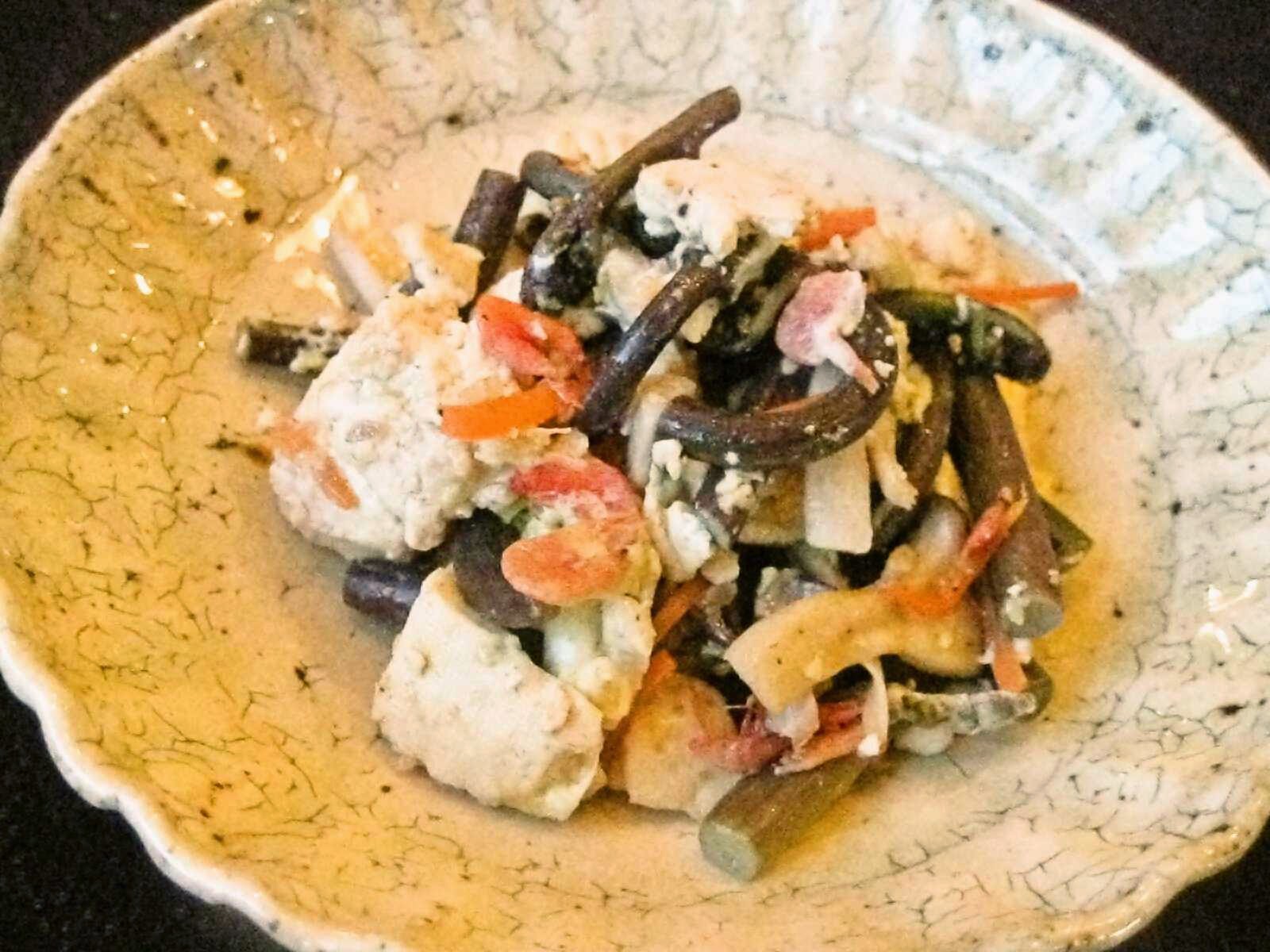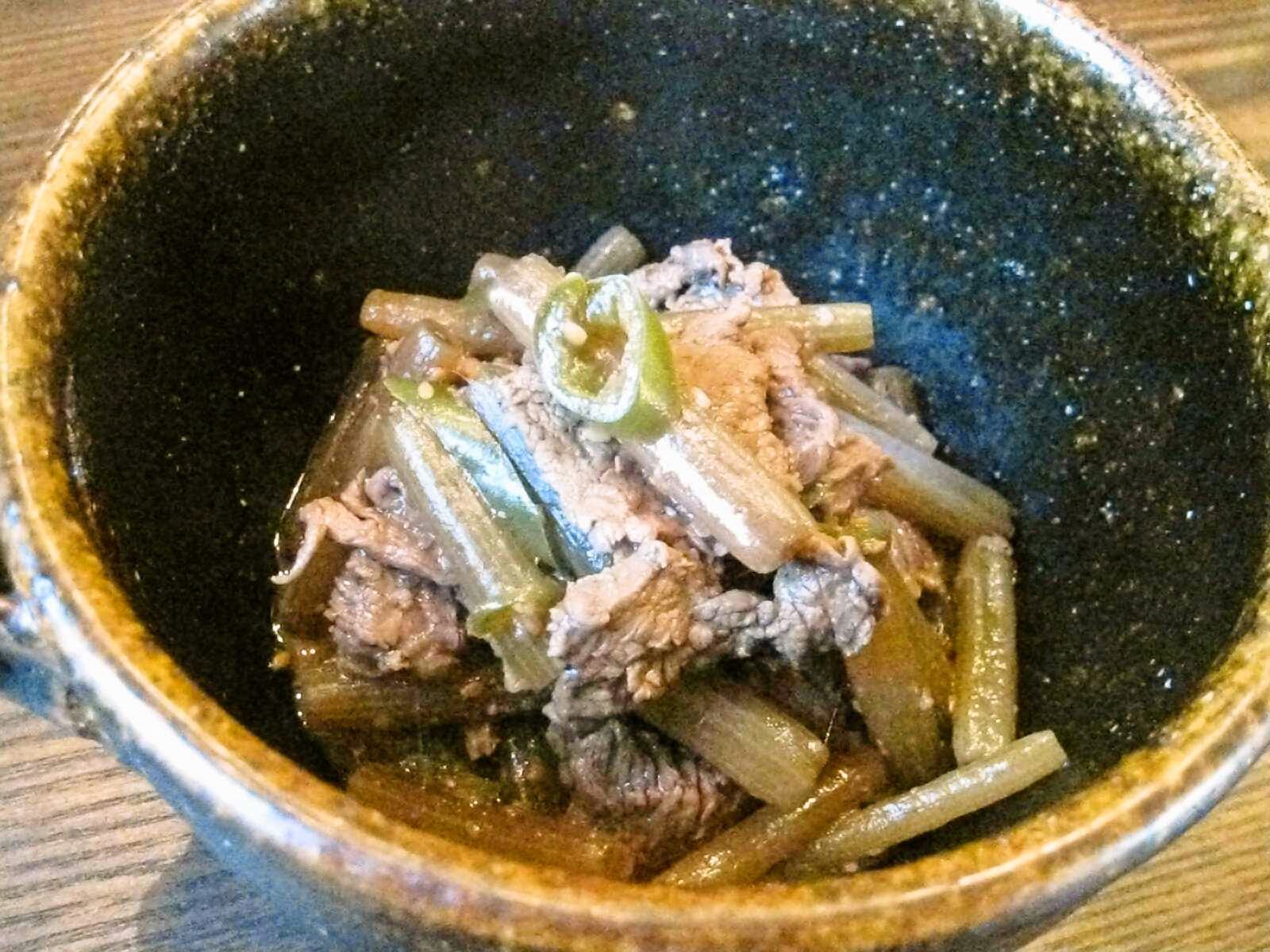Kogomi fiddleheads of kusasotetsu ostrich fern (Matteuccia struthiopteris)
All recipes are for 2 servings unless noted. Oil is canola oil and salt is kosher salt.
2014-05-30
Kogomi ostrich fern fiddleheads & seiyo meshida lady fern fiddleheads
Kogomi fiddleheads of kusasotetsu ostrich fern (Matteuccia struthiopteris)
2014-05-28
Seiyo meshida no gomaae / lady fern fiddleheads in sesame dressing
One of the typical dishes for kogomi ostrich fern fiddleheads in Japan. The recipe below uses locally harvested lady fern fiddleheads. The refreshing taste and aroma of succulent and crispy fiddleheads blend wonderfully with the slightly sweet and toasty taste of sesame dressing. Using the freshest fiddleheads, ideally ones harvested the same day, is the key to bringing out the best taste.
1/2 of recipe (when using kogomi):
28 calories; 1.5 g protein; 1.3 g fat; 2.8 g carbohydrate; 1.1 g net carbs; 58 mg sodium (with 50% reduced sodium; 116 mg with regular soy sauce); 0 mg cholesterol; 1.7 g fiber
1/2 of recipe (when using kogomi):
28 calories; 1.5 g protein; 1.3 g fat; 2.8 g carbohydrate; 1.1 g net carbs; 58 mg sodium (with 50% reduced sodium; 116 mg with regular soy sauce); 0 mg cholesterol; 1.7 g fiber
Labels:
1 very easy,
30 min,
bento,
blanch,
kogomi,
lady fern,
Recipes - Japanese,
reduced sodium,
seiyo meshida
2014-05-27
Fuki to tofu no akadashi / red miso soup with Japanese butterbur and tofu
Labels:
1 very easy,
30 min,
fuki,
miso,
Recipes - Japanese,
reduced sodium,
sake lees,
sakekasu,
soup,
tofu
2014-05-25
Ebi to kobashira no gorugonzoora soosu guratan / shrimp and bay scallop gratin with gorgonzola cheese
One of my favorite mac & cheese – a great pairing of gorgonzola cheese and shrimp and scallops. The taste can run from rich to light depending on whether you use heavy cream, milk or soy milk, or a combination. Below is an indulgent dairy version for me, featuring heavy cream and milk, yet the green vegetable (yu choy sum) lightens up the aftertaste for a pleasant flavor overall. Great with wine!
1/2 of recipe:
548 calories; 29.4 g protein; 28.5 g fat; 38.6 g carbohydrate; 34.8 g net carbs; 408 mg sodium; 191 mg cholesterol; 3.8 g fiber
1/2 of recipe:
548 calories; 29.4 g protein; 28.5 g fat; 38.6 g carbohydrate; 34.8 g net carbs; 408 mg sodium; 191 mg cholesterol; 3.8 g fiber
Labels:
3 moderate,
60 min,
bake,
bay scallops,
broil,
gorgonzola,
gratin,
panko,
parsley,
pasta,
Recipes - Western,
reduced sodium,
saute,
shrimp,
yu choy sum
2014-05-23
Soba to warabi no ponzu sarada / buckwheat noodle and bracken salad with citrus soy sauce
Warabi's succulent texture pairs well with soba buckwheat noodles and ponzujoyu. As warabi needs a bit of time to absorb flavor, it is cooked in dressing for the quick fix below.
1/2 of recipe:
251 calories; 8.3 g protein; 5.4 g fat; 43.4 g carbohydrate; 39.4 g net carbs; 223 mg sodium (with ponzujoyu made with 50% reduced sodium soy sauce); 0 mg cholesterol; 4.0 g fiber
1/2 of recipe:
251 calories; 8.3 g protein; 5.4 g fat; 43.4 g carbohydrate; 39.4 g net carbs; 223 mg sodium (with ponzujoyu made with 50% reduced sodium soy sauce); 0 mg cholesterol; 4.0 g fiber
Labels:
3 moderate,
30 min,
boil,
mizuna,
ponzu,
ponzujoyu,
Recipes - Japanese,
reduced sodium,
salad,
saute,
simmer,
soba,
tomatoes,
warabi
2014-05-20
Warabi to eringi no iridofu / scrambled tofu with bracken and king oyster mushrooms
Iridofu scrambled tofu is a wonderful way to showcase any in-season vegetable. Warabi bracken is no exception. As warabi is a great match with shrimp and mushrooms, the dish takes advantage of sakura ebi (for an underlying toasty note) and eringi mushrooms (for a hint of sourness). A delightful everyday meal companion.
1/2 of recipe:
128 calories; 10.0 g protein; 7.2 g fat; 6.9 g carbohydrate; 3.4 g net carbs; 169 mg sodium (with 50% reduced-sodium soy sauce, 198 mg with regular soy sauce); 61 mg cholesterol; 3.5 g fiber
1/2 of recipe:
128 calories; 10.0 g protein; 7.2 g fat; 6.9 g carbohydrate; 3.4 g net carbs; 169 mg sodium (with 50% reduced-sodium soy sauce, 198 mg with regular soy sauce); 61 mg cholesterol; 3.5 g fiber
Labels:
1 very easy,
10 min,
bento,
carrots,
eggs,
eringi,
Recipes - Japanese,
reduced sodium,
sakura ebi,
saute,
shoyukoji,
stir-fry,
tofu,
warabi
2014-05-18
Fuki to gyuniku no Kankoku-fu nimono / braised Japanese butterbur and beef, Korean style
A small amount garlic and sesame seeds in the beef marinade add a Korean touch to this common pairing of fuki Japanese butterbur and beef. Serrano pepper becomes quite mild after simmering, so use more if you prefer something spicy. Adapted from "Bejikorian [Veggie-Korean]" by Jeon Kyonghwa.
1/2 of recipe:
141 calories; 12.2 g protein; 6.7 g fat; 5.9 g carbohydrate; 4.7 g net carbs; 196 mg sodium (with 50% reduced-sodium soy sauce & shoyukoji made with 50% reduced-sodium soy sauce, 354 mg with regular soy sauce and shoyukoji made with regular soy sauce); 35 mg cholesterol; 1.2 g fiber
1/2 of recipe:
141 calories; 12.2 g protein; 6.7 g fat; 5.9 g carbohydrate; 4.7 g net carbs; 196 mg sodium (with 50% reduced-sodium soy sauce & shoyukoji made with 50% reduced-sodium soy sauce, 354 mg with regular soy sauce and shoyukoji made with regular soy sauce); 35 mg cholesterol; 1.2 g fiber
Labels:
2 easy,
30 min,
beef,
bento,
braise,
fuki,
Recipes - Korean,
reduced sodium,
saute,
shoyukoji,
simmer
2014-05-16
Horenso to ebi, age no shiraae / spinach, shrimp and toasted thin deep-fried tofu in tofu dressing
A small side dish with spinach. While spinach alone tastes good with shiraae tofu dressing, pairing it with other ingredients opens up an intriguing world of different textures and tastes. Here is an example with shrimp and usuage thin deep-fried tofu.
1/2 of recipe:
67 calories; 6.5 g protein; 3.4 g fat; 3.1 g carbohydrate; 2.0 g net carbs; 104 mg sodium; 26 mg cholesterol; 1.4 g fiber
1/2 of recipe:
67 calories; 6.5 g protein; 3.4 g fat; 3.1 g carbohydrate; 2.0 g net carbs; 104 mg sodium; 26 mg cholesterol; 1.4 g fiber
Labels:
3 moderate,
30 min,
blanch,
microwave,
pan-fry,
Recipes - Japanese,
reduced sodium,
shoyukoji,
shrimp,
spinach,
tofu,
usuage
2014-05-15
Iridori / chikuzen-ni / braised chicken with root vegetables
A classic chicken and root vegetable dish. The softly sweet and salty taste makes it a great companion for plain rice and drinks. It is also a popular osechi dish for the New Year, and is great for bento and picnics.
1/2 of recipe:
213 calories; 12.8 g protein; 11.0 g fat; 14.7 g carbohydrate; 10.8 g net carbs; 243 mg sodium (with 50% reduced-sodium soy sauce & shoyukoji made with 50% reduced-sodium soy sauce, 429 mg with regular soy sauce and shoyukoji made with regular soy sauce); 62 mg cholesterol; 3.9 g fiber
1/2 of recipe:
213 calories; 12.8 g protein; 11.0 g fat; 14.7 g carbohydrate; 10.8 g net carbs; 243 mg sodium (with 50% reduced-sodium soy sauce & shoyukoji made with 50% reduced-sodium soy sauce, 429 mg with regular soy sauce and shoyukoji made with regular soy sauce); 62 mg cholesterol; 3.9 g fiber
Labels:
2 easy,
60 min,
bento,
braise,
broccoli,
carrots,
chicken,
dried shiitake,
gobo,
hoshi-shiitake,
konnyaku,
make ahead,
osechi,
picnic,
Recipes - Japanese,
reduced sodium,
renkon,
shoyukoji
2014-05-14
Shoyukoji / soy sauce rice malt
Shoyukoji is technically the base of soy sauce in the production process (see Kikkoman website). However, today the term is more commonly used to mean a mixture of shoyu soy sauce and koji rice malt, which has become popular in the last few years in Japan and among the Japanese community overseas. Just like shiokoji salted rice malt, shoyukoji is full of umami. In fact, its glutamic acid content is said to be 10 to 15 times of that of shiokoji.
2014-05-06
Shiitake to warabi no buriichiizu-yaki / shiitake and bracken with brie cheese
Labels:
2 easy,
30 min,
bake,
brie,
broil,
cheese,
party,
Recipes - Western,
reduced sodium,
saute,
shiitake,
warabi
Subscribe to:
Posts (Atom)










